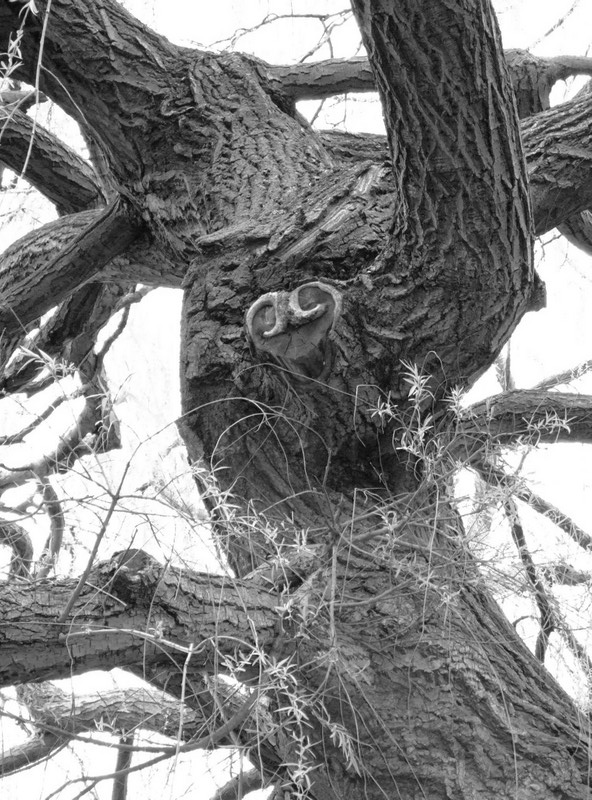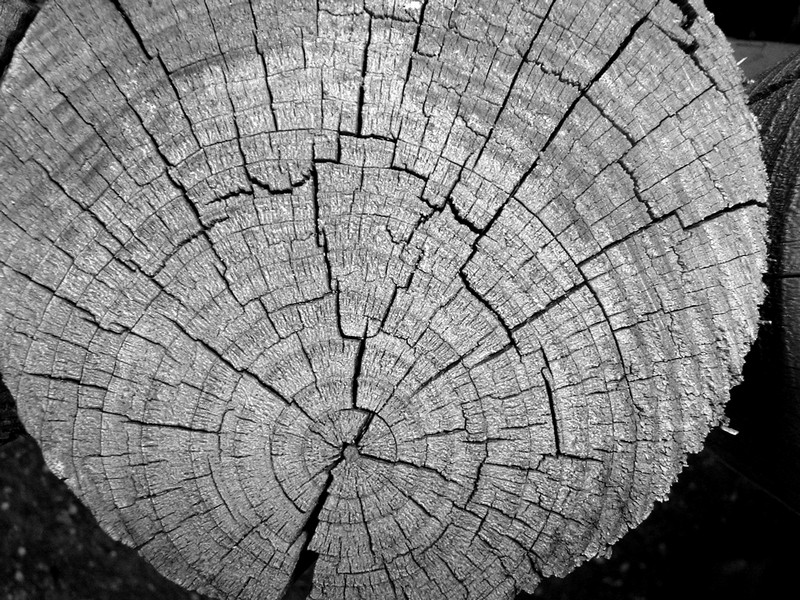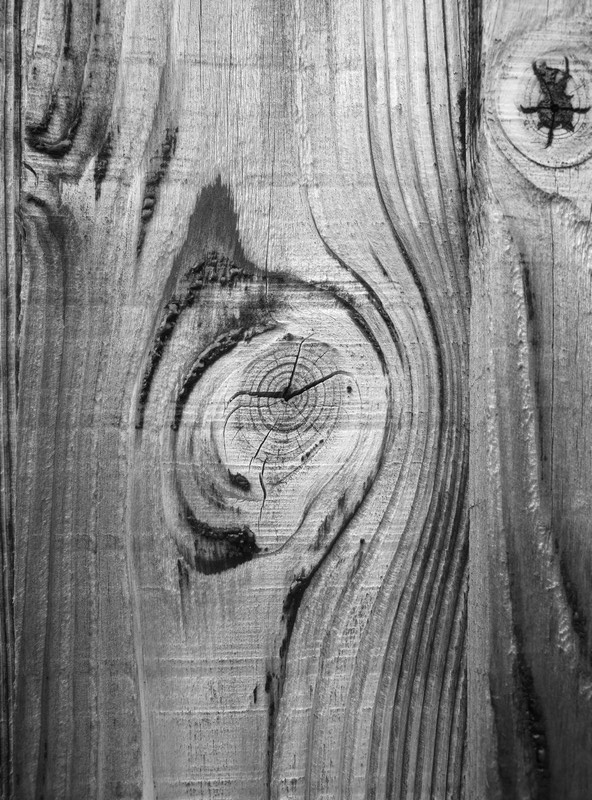Ivon Hitchens
Winter time is the best time ever for looking at books for me, and one of my favourites is my book on Ivon Hitchens. The work of Ivon Hitchens was introduced to me way back in 2010 by John T Freeman on a course at West Dean College. It made a big impression on me, mainly because it put the idea of poetry and painting together in my mind. I prefer his earlier paintings, and I especially like the Terwick Mill paintings, one of which I show you below.

Terwick Mill no. 14, Waterfall 1945 oil on canvas, (40.5 x 74 cm)
The period around Christmas is when I tend to do a lot of reading and get rather over excited about ordering books to read! Thankfully there are a lot of free books available via the local library and various apps! Audio books are even better, as boring things like cleaning and sorting out can be carried out at the same time! I’m dipping into “Fat is a Feminist Issue” by Susie Orbach at the moment. It’s interesting for me to increase awareness of how I tend to stuff down my emotions if I get the chance. She has lots of very interesting things to say about women and our relationship with food.
One little morsel to cherish ” The roots of compulsive eating in women stem from women’s position in society – she feeds everyone else, but her needs are personally illegitimate. Food, therefore, can become a way to try to give to herself. “
Quoted from “Fat is a Feminist Issue” by Susie Orbach
If I eat books, I think I will be Okay!
I have been true to habit of flitting from book to book, but it seems to work for me. I blame scrolling on the internet. I have got so used to it I tend to do it with all the kinds of reading I do. That’s one really big advantage of listening to audio books. I keep on track for longer!
Psyche, Body, Spirit…Unbound
Here is my recent mosaic…
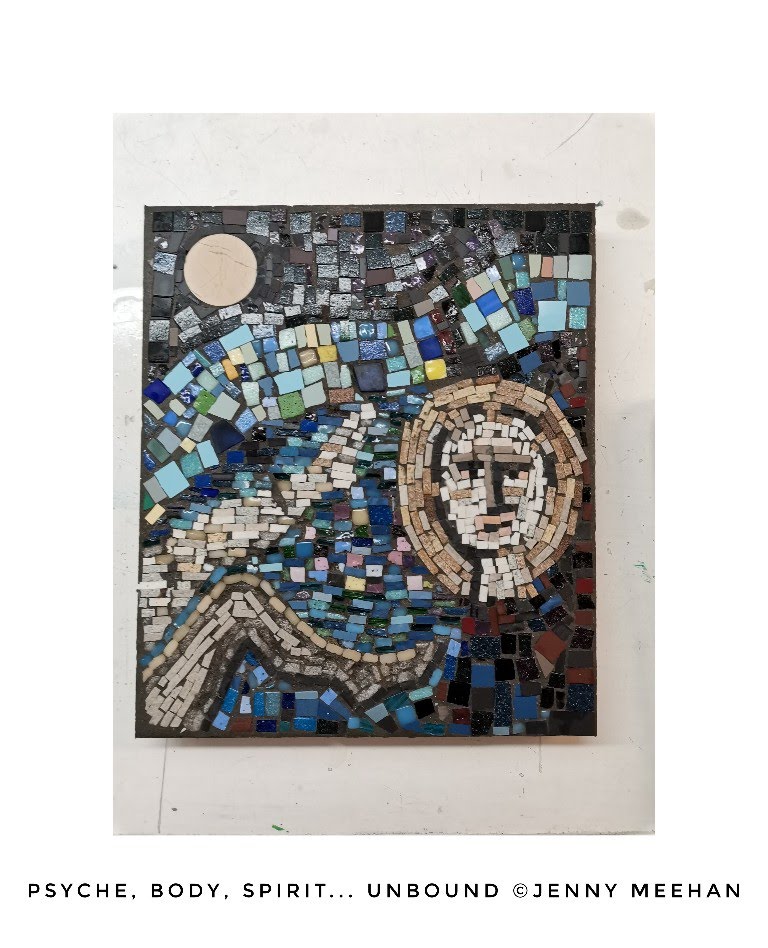
Psyche, Body, Spirit…Unbound Mosaic by Jenny Meehan
I still need to remove a few bits of grout but I’m posting up here while fresh in my mind.
Mosaic is not my main medium, for I am more of a painter-poet, but I need to paint in my garden mostly, as I don’t have a dedicated studio space. I do have a studio tent I constructed and that is good for many things, but it is still rather too cold and wet right now. In the Summer I can paint in the garden so space is not a problem then.
It’s kind of odd, this mosaic, in a quite interesting way. I like it when I make things which confuse me initially. Maybe that is the source of the peculiar expression! An online dictionary tells me that:
“A frown (also known as a scowl) is a facial expression in which the eyebrows are brought together, and the forehead is wrinkled, usually indicating displeasure, sadness or worry, or less often confusion or concentration.”
I was keen to create something with a surreal feel and also which contained a human face. A human face made of blocks of stone was bound to be interesting, I suppose. I like to ask friends how my work speaks to them because I always learn a lot from doing so. One friend very insightfully picked up on the sense of a journey, the presence of water, and that the face was an onlooker to the scene. Also that one leg was under the water and the other on top of the water. I can’t remember all her words, but they added a lot of depth to my own responses.
The mosaic, I realised, (as I was making it!), was part of my poem (which I wrote within the same time period) “The Mummy and the Pyramid. I started the mosaic ages ago in September and I didn’t have much of an idea of its meanings for me in any clear sense. Broadly, it was centred around self-realisation and self-actualisation. We know things at different levels. This is why contemplation and dwelling on things without rushing ahead is so valuable. This is probably why I have a passion for art and poetry. They do ground me! They help me to not avoid my emotions but rather to encounter them. So a good process.
I do love the way that when you are creating artistically, (if you allow yourself to be carried along in a stream of consciousness – not quite knowing what an earth you are doing, but allowing oneself to engage with it anyway) there’s such a mysterious yet rich area for thoughts and feelings to emerge and to listen to. I found the lengthy process of mosaic making helpful. It is so much longer than that of a painting; well, in its actual execution at least. My paintings do often have a dormant period where ideas are still in gestation! And a lot of thinking goes on then. But as I said, I did find there is something particularly grounding in mosaic making. Being forced to stay with something singular for so long is not my usual style. For my often flighty mind and ever changing focus, this is no bad discipline to develop.
So with the extended time spent working on one thing when I usually work on at least three, plus each session of mosaic making being at regular intervals (just as therapy is!) I think this gave me a lot of time for reflection and contemplation as the mosaic unfolded. In this manner, the poem came from the mosaic and the mosaic came from the poem. As the ideas for motifs to use in the mosaic came to mind in their own good time, and I floundered about with respect to a title, I then utilised the mosaic imagery into the poem, which in turn, kindly gave the mosaic it’s title! It was a good combo!
I am sure that, mostly, with mosaic making it is best to know what you are doing and have a set idea clear in your mind at the outset, but I am not used to working that way. Unless I have been painting for others (commissioned to produce something), I prefer to wander around in the dark in a piecemeal fashion, and so I am keeping that approach. This is very possible with small mosaics at least, though not so possible with large ones! It is the case however that composition is everything (well, not everything…but if the underlying structure isn’t there, (however random that may seem) the visual art struggles to stand on its own two feet in my mind. There is nothing like a nice sturdy composition!
Alongside this, though, there is also a great excitement and liberty in a complete loss of structure – in fluidity and flexibility – in possibilities which cannot be seen or predicted. In mystery. It is the interplay between structure and disarray – the tension – which creates a paradox. Paradoxes tend to be rich with depth and discovery, if we can bear to hold ourselves in the space between too apparent opposites.
I have, true to form, meandered!
You can hear the poem which interacts with the mosaic here, as I have put it up on my YouTube channel:
The poem also relates a little bit to an earlier poem (God has Helped/January 2022) in the respect that the earlier one had a resurrection theme to it. As here in this part:
“The memory box
This unsealed tomb
strung in curses of defiant
protection?
Evil, elemental
spirits
bound a bandaged
menace
refusing carriage to the other world?”
from “God Has Helped” by Jenny Meehan ©2022
You can listen to the whole poem here on my YouTube Channel as I created a video poem version at the end of last year https://youtu.be/WIZ1MHpLSSQ
I was dwelling on “God has Helped” and asking myself questions about it when I wrote “The Mummy and the Pyramid”. The Egyptian theme has been in my mind for a while because I spent a lot of time cutting out many Egyptian stencil motifs to use in my artwork at the beginning of the pandemic in 2020. I have always liked the paintings and motifs I have come across when looking at images of Egyptian wall paintings. Art Deco also draws inspiration from the art and architecture of ancient Egypt, and it’s my favourite decorative style of art!
A little bit of context needs to be kept in mind, for it was during the 1920’s when the Art Deco style emerged, and so its not hard to see how Egypt held a particular allure for artists and designers. The discovery of the tomb of the boy pharaoh Tutankhamun in November 1922 sparked a massive amount of popular interest. Generic Egyptian imagery began to be seen all over the place.
The flat, geometric, highly patterned, yet also narrative, visual combinations found in Egyptian wall paintings, plus the context of being inside a tomb, was such a pull when thinking about aspects of myself which have been repressed and/or suppressed, but which continually surface. To my mind, there is so much of any person which is like a mummy… Bound, yet ready for release and new life – if we grant it the grace and acceptance to allow it to live. I was thinking about sexuality, but this can be true for any aspect of the self I think.
For me to work on a pictorial piece of art, rather than my more frequent abstract paintings, has been a refreshing change. I think having the mosaic understood as part of something else, in this case a poem, feels very good to me as it has some context. A lack of specific context with a pictorial piece of art is a necessary yet uncomfortable situation I feel.. So there is comfort in its placement in my poem!
There is reference in the poem to “mortar and stone pieces” and while I was thinking primarily of a wall, I quite liked the hint towards the process of making a mosaic which I do think was in my mind when I wrote it. As I was reflecting on my mosaic and asking myself what on earth it could be saying to me I identified its three main symbolic elements as being body, mind and spirit, and this is how it came to then enter into the poem so fittingly.
I am quite relieved that the mosaic has a place in the poem because there is no place for it in the house it seems! I will find a good place for it soon I hope. It is hard when there is not much space! Guess I need to do a bit of a New Year sort out!
PS: I have an even older poem, which I wrote in the early years of my psychoanalytic psychotherapy, around 2012 “A Poem to my Therapist” which uses an Egyptian theme, so I am going to dig that one up as soon as I can find it and make a video poem of that too.
Guinness 0.0% Alcohol Free Draught Stout
..
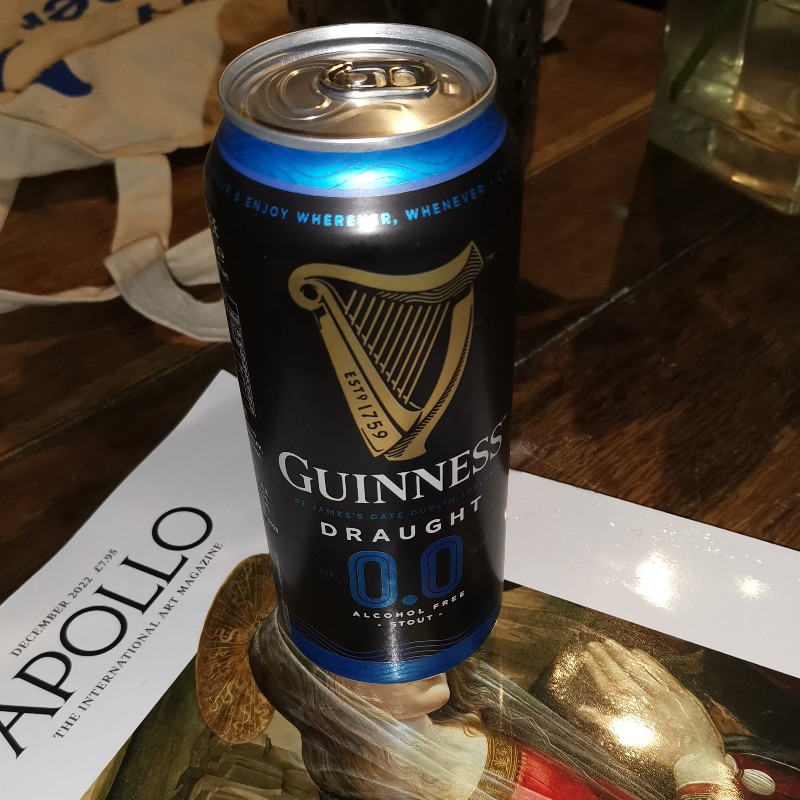
I can say this is easily my very best birthday present… alcohol free #guinness! 🙂
As someone who doesn’t drink alcohol (not since 2010!) I can say my very best Christmas (or was it Birthday? – as so close together I always get muddled!) present was this alcohol free Guinness! Hooray! Well, who would have guessed ten years ago this would have been possible! I’ve been meaning to try it out for ages and I won’t look back now!
Before my alcohol use became more accurately described as “alcohol use disorder” I used to drink just beer and stout. (until my thirties!) I only later started drinking wine. This means that it is wine which is the drink I associate with over drinking, so I’m finding the alcohol free Guinness not presenting any issues for me in terms of being a pull towards alcohol. Not everyone who chooses sobriety can take the alcohol free beer option but for me it’s a total win win!
It makes so much difference to have plenty of choice when you don’t consume alcohol. I have tried a few other alcohol free beers and lagers too. My favourite so far is the Lidl one. Lidl “Perlenbacher 0.0” is not too sweet and really inexpensive too!
Wine
Well, as I’m on the subject of drinking, (which seems to be a topic on many people’s minds, based on the frequency of it coming up in sauna conversations at my local leisure centre!) I might as well move onto wine.
I do take communion wine in church as it is part of The Eucharist. In fact, I have found that because it is consumed in this context, it is more meaningful to me. The reason for this, is that this is the only place I take some wine. The term “Eucharist” originates from the Greek word eucharistia, meaning thanksgiving. And when I take the wine in that context it resonates very deeply for me in it’s associations with the blood of Christ. It is a simple symbolic ritual for me which helps me to recognise the reality of Christ’s life blood in me.
This very positive recognition of faithful love is a blessing to me. Instead of me drinking wine in a destructive way – consuming a substance in order to anaesthetise my pain, which is what I used to do – I drink the wine to honour Christ’s love and sacrifice. In this symbolic ritual I partake in Christ’s life giving love in a metaphorical sense. That it is metaphorical does not devalue it to my way of thinking, (though there are many different approaches to the matter and disagreements about this!).
It’s a small part of a much bigger picture. Partaking in the life of Christ is an experience which goes far beyond the altar and into every realm of life and experience if we let it do so. I rather like Richard Rohr’s words:
“Eucharist is presence encountering presence — mutuality, vulnerability.”
( from “Eucharist as Touchstone” )
With this thought in mind, and very much inspired by a recorded poetry reading by Judy Grahn on YouTube, I’ve written this poem! “I Paint You”. It is the partner piece for my painting “The Ruined Woman” (Which is in turn part of a Trilogy (Exhibit 1: “The ruined woman” (a painting – poem) Exhibit Two: “Venus de Milo” (sculpture and also video “Artefact/Artifact” ) and Exhibit Three: “Violence Vigil – Watch and Pray”.(short film)
Here’s a low res image of “The Ruined Woman”

The Ruined Woman ©jenny meehan partner to “I Paint You” by Jenny Meehan
I Paint You
Turn
turn to
face the future
yes
you
are wine
woman.
There is wine
Your beaker
blood promises
not death
but life
Your beaker is not empty.
Turn, turn –
Face
the future –
Build
Speak
Weave
Know
you are old and young in one.
You are not alone.
No one
taints you
scars you
mars you
stop you
drops you
Empathy is the water
that moves and spreads you
Empathy formed with
a nerve
of steel
Am I not
soft and tender?
My fine form comes
from my centre.
It is a hurricane.
May be
protestations for blood spilt
without evidence.
Am I not
an error
.No.
Written by © Jenny Meehan 2023
Slowly: a plainsong from an older woman to a younger woman Poem by Judy Grahn can be read here among other places:
https://www.poemhunter.com/poem/slowly-a-plainsong-from-an-older-woman-to-a-younger-woman/
(I hope if permission granted to post it here too if possible)
But even better than that, you can listen to it on YouTube now! Also, the YouTube video is an old recording of Judy Grahn reading her poem herself, which is clearly the best way to receive any poem (from the lips of the person who writes it) . The recording of Judy Grahn reading her poem is also different to the text I’ve found online as it is much longer. It may be she edited it down later? I do this a lot and I’m sure many other writers do. Indeed, as all artists with our work, we tend to reflect and refine with the passage of time. I do like the spoken word version best though.
The link to Judy Grahn reading “Slowly: a plainsong from an older woman to a younger woman” is here:
It’s simply amazing to listen to… A total inspiration, and I know I’ll be looking through the Poetry Foundation’s Archives a lot this year. It is also possible to see the full recording via the Poetry Foundation. Here is more information here in the text included in the Poetry Foundation website:
“The Poetry Center presents Judy Grahn and Diane Wakoski, appearing at the San Francisco Museum of Art, each reading from new work on a program of women poets organized by The Poetry Center and introduced by director Kathleen Fraser. Grahn reads from a long prose work in progress, and from the She, Who poems. The latter at the time is noted as being prepared for publication with the Women’s Press Collective, which was located in the basement of A Woman’s Place Bookstore, on Broadway in Oakland. Wakoski reads three works in manuscript, a poetic essay followed by two longer poems, from her yet to be published book, Virtuoso Music for Two and Four Hands (Doubleday, 1975).
Note: the original event also included a third poet, Grace Harwood, video for whom is unavailable.”
The recording of “Slowly – A Plain Song from an Older Woman to a Younger Woman,” on YouTube was the last poem Judy Grahn read at the event. This was a poem she described as “having to do with the two kinds of women that there are: older ones, and younger ones. She made heavy use of “feminine rhymes,” which Webster’s dictionary notes are not listed in the dictionary, as these two-syllable rhymes are “trivial and used only for humor.”
I took a brief look but couldn’t find it (the dictionary quote) online however I have no doubt that’s its there. I did find this, as I was interested in the grammar of “Am I not”
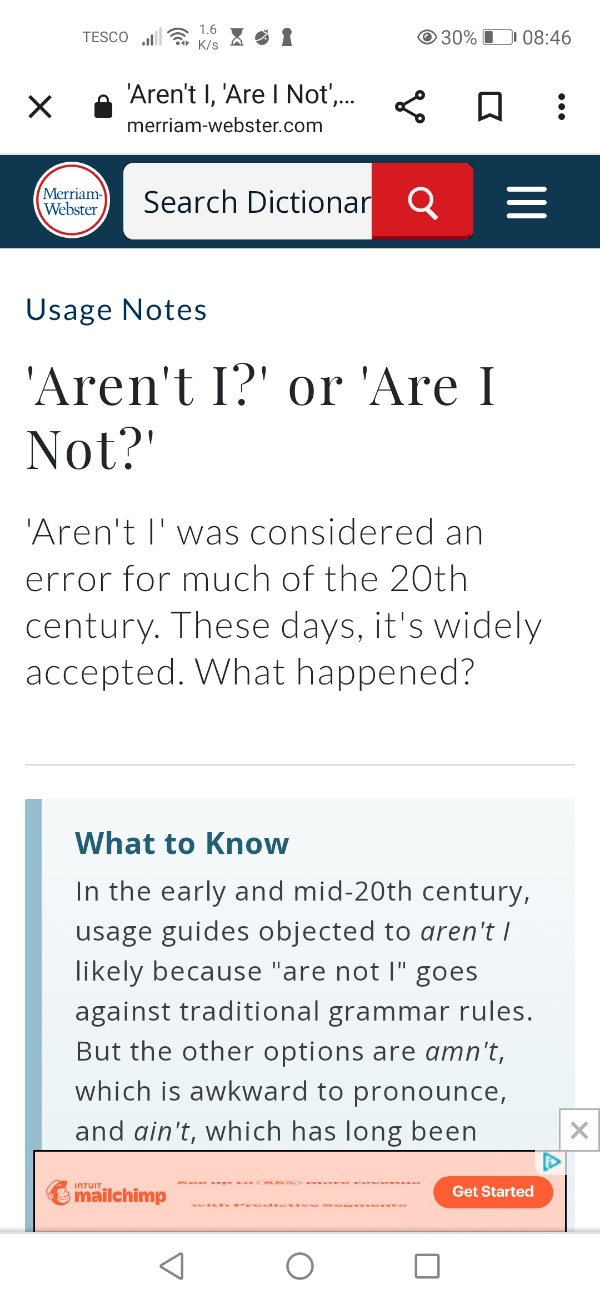
I like very much the use of “Am I not” in Judy Grahn’s poem, so I used it in my poem too. It’s rather formal and detached I think. I see from the dictionary it’s far from “Ain’t I”! (I can remember using that expression on my youth, but have dropped it and acquired more of a Surrey accent, along with traces of South London! Ain’t I posh! 😂)
Another thing I noticed and liked very much is the way question marks are not used with “Am I not”. A certainty underlies the question. It makes it bold and brave. Going against traditional grammar rules is something I could consider, and this includes punctuation. This is why I end with “.no.”
I have read many poems over the years with non standard grammar and/or punctuation, but recently I tried hard to use it more conventionally. This is helpful for other people reading, but for me as I move more into speaking out aloud my own work more I think it could be a bit restricting so I need to reconsider how much it matters. I struggled at school with reading, writing, spelling and grammar and though I wasn’t quite in the “lowest” group for such things (though I did feature in the remedial reading group at Infant School I am proud to say!) I was below average.
You should never underrate a good teacher though. My English teacher at secondary school was both tough and faith-full. She believed for the best and as when I exited Twickenham Country Girls School, though wasting a lot of it, I could carry an A in English Language and a B in English Literature, which was pretty amazing bearing in mind the circumstances of my life at that time! Being beaten up by the gang of girls I hung out with in the fifth year was bad, but suddenly I had nothing to distract me and I realised I needed to come out of school with something to show for it.

jenny meehan in West Dean Forge
Thinking on steel takes me right back to many happy times in the forge at West Dean College. I took part in several blacksmithing courses. As well as working with steel, I also experimented with other metals, such as copper and aluminium on a couple of courses led by Mike Savage.
That quick trip down memory lane reminds me that I really need to work on getting back to that size this year I think. Though keeping “Fat is a Feminist Issue” in my mind at the same time, of course!
Shortcomings
“Shortcomings, both real and imagined, when deeply seen and accepted, are an important part of the transformative process of learning to let go. If we do not let go of the need to be perfect, our need to be perfect will get in our way. Likewise, if we do not let go of our fear of failing, our fear of failing will get in the way. But as we learn to let go of the need to be perfect and the fear of failure, the intimate, earthy stuff of being a vulnerable, loving human being begins to shine through. In an ongoing process of learning to let go we bear witness to the great truth that the master limps. The mastery of life is intermingled with the ongoing weaknesses and limitations that gives life its rich and many layered texture and meaning.”
Copyright © 2013 Dr. James Finley
Thanks to Dr. James Finley for permission to quote in this Jenny Meehan Contemporary Artist’s Journal.
“the intimate, earthy stuff of being a vulnerable, loving human being begins to shine through.”
I need to read that again!
And importantly the “learning to let go”. This is not something we find easy in life! We want control. We want to know.
I attended a “Silence in the City” Retreat Day led by Dr James Finley many years ago and it gave me plenty of food for thought. It was called Transforming Trauma: Exploring the Healing Power of Spirituality (A one day healing retreat) and was described as being
A one day retreat devoted to exploring the healing power of spirituality. The day’s reflections will focus on seven traumas or wounds to which we are all subject as human beings and then go to explore methods of meditation and other steps we can take to help ourselves and others heal from each of these seven wounds. The emphasis will be on the lifelong process of learning to be a healing presence in the midst of the world. Time will be given for brief periods of silent group meditation and discussion of the themes presented. Those in ministry, in the healing professions, trauma survivors and all who are interested in exploring healing power of spirituality in their own life and in today’s world will benefit from this day of prayerful reflection.
It was VERY good. I’m rather partial to a retreat day on a regular basis. I find it very helpful!
Over the years I have attended many similar type events and also many retreat days in various places, including the Mount Street Jesuit Centre in London.
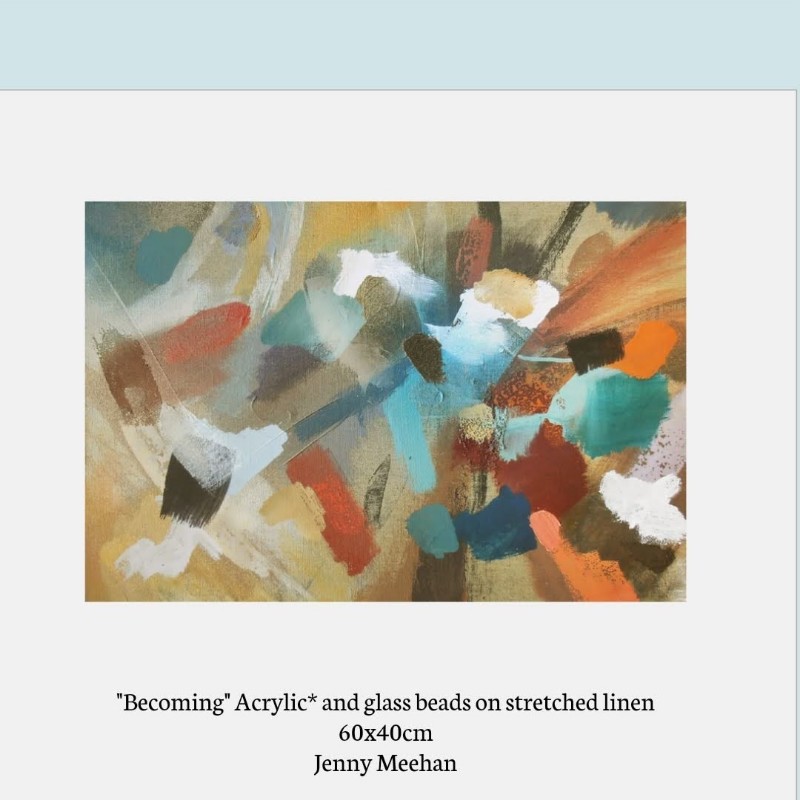
Becoming Painting © Jenny Meehan
Photographic Images from my Archive
I have lots of images of metal and wood, but here is a selection of some wood ones. Both the outside of trees, with the wonderful variation of bark, and the inside, which is revealed in objects such as fence panels and anything else made of wood, is always very visually inspiring to me. It is the flow of the lines which runs with fluidity, even in and on the solid wood, which captures my eye and leads me to press the shutter, even for the most mundane of objects. Things of interest and beauty are so easily overlooked, but the camera does help to isolate things in a way which draws the attention to them, which can be helpful. These images are the snap shots which help me remember the sights which beckoned to me, at different times of my life.
It has to be said that one of the unexpected benefits feeling very downcast and low in spirit, can be that one’s eyes fall naturally to the ground more often than most, and there, if one is willing, it is possible to find a treasure trove of images which might be missed otherwise. This is not to trivialise the problems, or the pain, but I have realised for myself, that it was in my darkest days (I would place this period as being between 2007 and 2011) that I took most of my “under the waist” level images, many of the ground, and many which focused on fixings, outbuildings and structures of many kinds, and various boundaries, ie, walls, fences, and barriers.
I found a heart on the outside of the willow tree at Broom Road Recreation Ground, which I visited with my own children. Broom Road Recreation Ground, Trowlock Way, Teddington, TW119QY, was the park I was taken to as a child ( was brought up in Teddington, Middlesex.) It looks as if, where the branch was cut off, the heart then formed.
The three images above were taken in my local area, Chessington, as I ferried the children to and from school when they were younger.
The two images above were taken at West Dean College during one of the short courses I attended there.
Design and Artists Copyright Society DACS
Please note that the visual art on this online journal is the fruit of a lot of labour. It may not be used without permission. The same goes for any of my own writing, poems, and also, if included on this blog, the work of other artists is indeed their work. Permission needs to be requested from the relevant artists before use is made of it, even when that use is non-commercial.
So, having made that clear…
Do you need a licence to use one of my images?
I’m a member of the Design and Artists Copyright Society, (DACS) and my digital images are licensable via DACS.
Please contact me in the first instance with your enquiry. I’m flexible about fees, which are based on the industry standard, but negotiable. NOTE :All fees cited by the Design and Artists Copyright Society are proposed; not set in stone; and depending on circumstances, budgets, the nature of your project etc I can be flexible.
To get an idea of the industry standard fees for an image licence take a look at the Design and Artists Copyright Society Information page:
https://www.dacs.org.uk/licensing-works
The Design and Artists Copyright Society is an informative website and a good introduction to the process of licensing an art image for anyone seeking an image to use who is not familiar with the process, what information is needed, etc.
I am also happy to help you personally though as well, and have an extremely large archive of digital art images so do feel free to contact me directly and give me an idea of your project, intended use, and requirements.
Remember..
DACS will automatically propose a licensing fee in line with the industry standard. However, please note, this is a negotiable fee. I am happy to be flexible about the initial fee proposed, and it’s not a problem if the initially proposed fee is outside your budget.
It works like this…
Administration of the licensing process is facilitated through the Design and Artists Copyright Society (DACS), who liaise between us with respect to the exact fee agreed. Depending on circumstances and the nature of your project, I can usually offer fee reductions for a certain percentage of licensing arrangements.
If you decide you want to use their online form, then you need to attach the low resolution image of my artwork which you have found on the internet, they will know which image you seek permission for.
As I’ve said, you can also contact me informally, in the first instance if you wish to, of course. Any formal arrangements will need to be made through the Designer and Artists’ Copyright Society, but I can often offer the opportunity to alter images, for example, putting in different aspect ratios or colourways, so it’s really helpful to communicate with designers and clients first with respect to the actual image required.
So, feel free to contact me. I will also be able to let you know the maximum size the digital image is available at. If you then wish to licence the artwork image, you would then contact the Design and Artist Copyright Society to arrange the licencing agreement according to your requirements. Once paid and agreed, I then supply the high resolution image directly to you.
Contact Jenny Meehan UK Artist Designer
I’m trying to remember to insert contact forms regularly in my blog posts! Do please follow me on WordPress and if you want to be put on my mailing list then let me know! I only send out a maximum of TWO artist newsletters each year!
